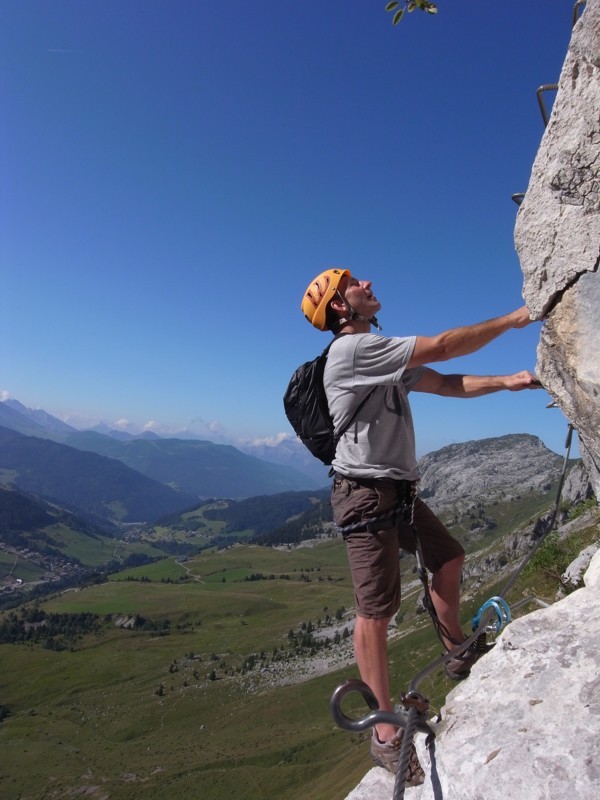- Details
- Written by: Jim
‘La Tour du Jallouvre’ – it sounds like a gentle amble around the hills; and if you’re a hardened rock climber it probably is.
But for my mate Nick it was his first via ferrata – and I have little doubt that it won’t be his last. Before we were even half way up he was raving about what a great crack the whole thing was; by the time we’d finished he was planning his next outing – “This is brilliant, I’d no idea it would be so much fun!”
The Tour du Jallouvre is as good an introduction to via ferrate as you could get; not only does it have some pretty testing vertical sections, an exciting wobbly bridge and views to die for, it’s also south facing so you can top up your tan as you climb.
Located above the alpine resort of Le Grand Bornand on the way up to the famous Col de la Colombière (you’ll see scores of cyclists huffing and puffing their way up the twisty road way down below you as you take a breather from the climbing), this corner of the French Alps is particularly lovely and reminded me of a scaled down version of the Dolomites.
Limestone peaks rise above green, flower speckled meadows within which sit the villages of Le Grand Bornand, Manigod, La Clusaz and St-Jean-de-Sixt, all better known for their skiing than as summer destinations.
It’s that limestone that helps make the via ferrate here so enjoyable – as any rock climber will tell you, sun warmed limestone is the finest material on which to climb, with big holds and good grip being de rigeur.
Not that you even need big holds on La Tour du Jallouvre. Like all via ferrate the 450-metre high route has a series of iron steps and hand holds drilled into the rock face, all linked by a steel cable running alongside, which means that anyone with a sense of adventure and a head for heights can take it on - tied in via your harness to the cable any fall you’re unfortunate enough to suffer will be of no more than a few feet (although it will probably still hurt).
This particular route is graded TD- (Tres Difficile minus); like British climbing routes ‘very difficult’ actually means ‘relatively easy’ – so much so that towards the foot of the route we encountered a local shepherd accompanied by his young son, the pair of them using the via ferrata to access their flocks higher up the mountain.
Although anyone who has a couple of via ferrate under their belt could readily climb the Jallouvre without a guide, we’d been provided with local mountain guide David Picchedda for our foray onto the ironwork.
David proved an excellent choice – his affable, easy-going nature and excellent English meant that not only could he inform us about the ever-widening panoramas of the Aravis and Chablis ranges we beheld as we beheld as we climbed, he could also take part in the banter and jokes that accompany a couple of mates enjoying themselves on a via ferrata.
He also provided a little historical perspective on via ferrate. “They were originally built in the Dolomites in Italy to assist with troop movements and battle operations in the First World War; but in the 1990s we started to build them in France purely for recreation – the two via ferrate here were some of the first in France”.
As the Jallouvre gets higher it becomes more vertical and more challenging until you eventually encounter the ‘crux’ section directly above what we and no doubt most other climbers call the ‘wobbly bridge’. Correctly known as ‘La Passarelle du Gypaète’ after the huge vultures of the same name that can be seen circling the crags and picking at the bones of fallen via ferrataists (only joking), it’s a 25-metre length of planks held together by various bits of steel cable and a good measure of jiggery-pokery and it sways above a drop of several hundred feet like a drunk at a wedding. What fun!
The fun gets more intense once you’re on the far side of the bridge as you hit the longest vertical section of the Jallouvre – in fact I could swear it was bordering on overhanging in places.
And herein lies the peculiar joy of climbing a via ferrata; you know that to all intents and purposes you’re safe and can’t fall more than a few metres; but you’re clambering up a sheer rock face above a vertiginous drop which can be either exhilarating , vertigo-inducing or a mix of both depending on your attitude to such things.
Fortunately for myself and Nick we were on the exhilaration side of that particular Venn diagram, and by the time we’d topped out on the Jallouvre and were enjoying our sandwiches and the sweeping views over mountains and valleys, plans were afoot for our next via ferrata ‘expdition’.
It could well be in the same area too; our climb had taken us around four hours (although the ‘official’ time for the route is 5-6 hours) which meant we had the afternoon free, so with the superb mountain biking, road cycling, rock climbing and hiking available locally this is a top place to base yourself for a week or more of alpine adventures.
ADDITIONAL INFO
The La Clusaz/Grand-Bornand area has:
2 via ferrata
600 rock climbing routes
196km of marked mtb trails
13 lift accessed mtb downhill trails
2 bike parks
90km of marked hiking trails
www.lakeannecy-skiresorts.com
www.laclusaz.com
www.legrandbornand.com
Alf Alderson stayed at the excellent value two-star Hotel La Montagne in La Clusaz www.clusaz.com/index-2-4h.html




